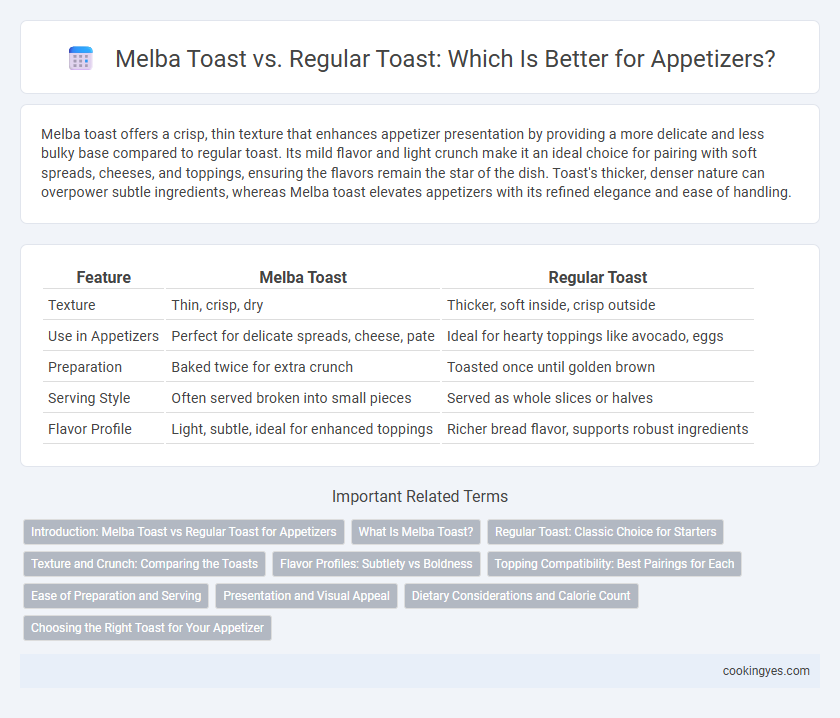Melba toast offers a crisp, thin texture that enhances appetizer presentation by providing a more delicate and less bulky base compared to regular toast. Its mild flavor and light crunch make it an ideal choice for pairing with soft spreads, cheeses, and toppings, ensuring the flavors remain the star of the dish. Toast's thicker, denser nature can overpower subtle ingredients, whereas Melba toast elevates appetizers with its refined elegance and ease of handling.
Table of Comparison
| Feature | Melba Toast | Regular Toast |
|---|---|---|
| Texture | Thin, crisp, dry | Thicker, soft inside, crisp outside |
| Use in Appetizers | Perfect for delicate spreads, cheese, pate | Ideal for hearty toppings like avocado, eggs |
| Preparation | Baked twice for extra crunch | Toasted once until golden brown |
| Serving Style | Often served broken into small pieces | Served as whole slices or halves |
| Flavor Profile | Light, subtle, ideal for enhanced toppings | Richer bread flavor, supports robust ingredients |
Introduction: Melba Toast vs Regular Toast for Appetizers
Melba toast offers a crispier texture and thinner profile compared to regular toast, making it ideal for delicate appetizers like pates and spreads. Its light, dry crunch complements toppings without overpowering flavors or absorbing moisture, enhancing presentation and taste. Regular toast, thicker and softer, provides a heartier base suited for robust toppings but may become soggy faster in appetizer settings.
What Is Melba Toast?
Melba toast is a thin, crispy slice of bread toasted twice to achieve a light, crunchy texture perfect for appetizers and hors d'oeuvres. Unlike regular toast, which is thicker and softer inside, Melba toast is designed to hold toppings without becoming soggy quickly, making it ideal for serving spreads, pates, and cheeses. Its delicate crispness enhances the presentation and texture contrast in appetizer platters.
Regular Toast: Classic Choice for Starters
Regular toast offers a warm, crispy base that complements a wide range of appetizer toppings, making it a versatile choice for starters. Its softer texture compared to Melba toast allows for easier spreading of creamy cheeses, dips, and spreads, enhancing the overall flavor experience. Commonly made from white or whole grain bread, regular toast provides a familiar, satisfying crunch that pairs well with both savory and sweet ingredients.
Texture and Crunch: Comparing the Toasts
Melba toast offers a distinctively crisp and dry texture that enhances appetizers by providing a light, crunchy base without overpowering toppings. Regular toast has a softer crumb with a firmer crust, delivering a chewier bite that complements hearty spreads and dips. The choice between Melba and regular toast hinges on the desired crunch level and how the texture interacts with accompanying flavors.
Flavor Profiles: Subtlety vs Boldness
Melba toast offers a delicate, crisp texture with a mild, slightly nutty flavor that enhances toppings without overpowering them, making it ideal for subtle appetizers. Regular toast delivers a heartier, robust taste with a chewy interior and crispy crust, providing a bold base that complements stronger-flavored spreads and toppings. Choosing between Melba toast and regular toast depends on whether the appetizer calls for a nuanced or pronounced flavor profile.
Topping Compatibility: Best Pairings for Each
Melba toast offers a light, crisp texture that pairs exceptionally well with pates, soft cheeses, and delicate spreads like smoked salmon mousse, enhancing subtle flavors without overpowering. Regular toast provides a sturdier, heartier base ideal for robust toppings such as avocado, tomato bruschetta, or melted cheese, supporting heavier, more textured ingredients. Choosing Melba toast or regular toast depends on the desired appetizer's flavor intensity and topping moisture level, ensuring perfect balance and presentation.
Ease of Preparation and Serving
Melba toast requires minimal preparation, as it is thinly sliced and pre-toasted, making it ideal for quick assembly of appetizers. Regular toast demands more cooking time and care to achieve the desired crispness, which can delay serving. Both offer versatile bases, but Melba toast's uniform crunch and size simplify portion control and presentation at gatherings.
Presentation and Visual Appeal
Melba toast offers a thinner, crispier texture that enhances the presentation of appetizers with its elegant, uniform shape and golden-brown color. Regular toast provides a heartier, rustic appearance but can appear bulkier and less refined on a platter. The delicate, lightweight nature of Melba toast allows toppings to stand out visually, making it a superior choice for sophisticated appetizer displays.
Dietary Considerations and Calorie Count
Melba toast offers a lower-calorie alternative to regular toast, with approximately 30-35 calories per slice compared to 70-80 calories in regular toast, making it suitable for calorie-conscious diets. Its thin, crisp texture provides a lighter base for appetizers, appealing to those seeking reduced carbohydrate intake or gluten-free options if made from alternative grains. Melba toast's lower fat and sodium content also supports heart-healthy eating plans, enhancing its suitability for dietary restrictions without sacrificing crunch or flavor.
Choosing the Right Toast for Your Appetizer
Melba toast offers a crisp, thin texture that enhances delicate appetizers like pates and soft cheeses, providing an elegant crunch without overpowering flavors. Regular toast is thicker and heartier, making it ideal for robust toppings such as avocado spreads or bruschetta, delivering a satisfying bite and supporting heavier ingredients. Selecting the right toast depends on balancing the appetizer's texture and flavor intensity to create a harmonious bite.
Melba toast vs regular toast for appetizers Infographic

 cookingyes.com
cookingyes.com